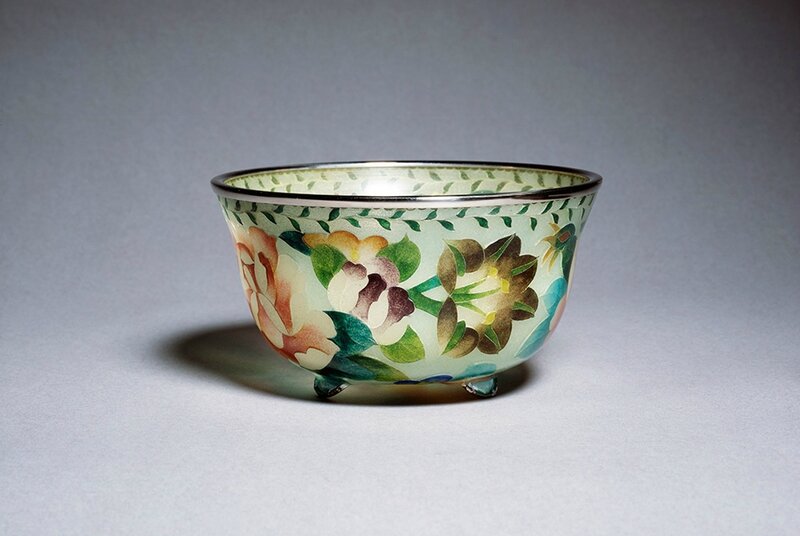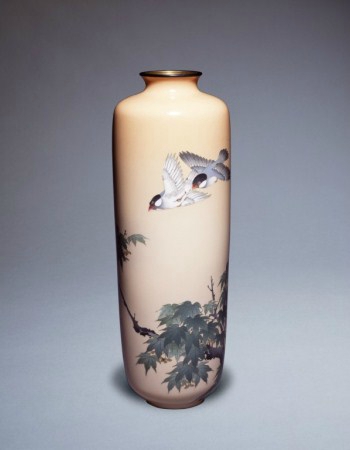Japanese cloisonné enamels from the Victoria and Albert Museum on view at the Chester Beatty Library
Vase, Kyoto; the mark of Namikawa Yasuyuki, c.1875-80. Cloisonné enamel. V&A: FE.67-2011. Gift of Edwin Davies. © Victoria and Albert Museum, London.
DUBLIN.- One of the world’s finest collections of Japanese cloisonné enamels went on display at the Chester Beatty Library, Dublin on 14 March 2015. The collection, on loan from the Victoria & Albert Museum, London, provides an insight into one of Japan’s most exquisite art forms. Seven Treasures: Japanese Cloisonné Enamels from the Victoria and Albert Museum, London is free to the public and continues at the Library until 14 June 2015.
Cloisonné enamels were among Japan’s most successful exports in the late 19th century, reaching a peak of artistic and technological sophistication between 1880 and 1910, a period referred to as the ‘Golden Age’. This exhibition showcases over one hundred enamels, almost 90 of which were donated from the collection of Mr Edwin Davies CBE, with the others from the V&A’s historical collection which dates from the Paris International Exposition of 1867.
The V&A exhibition complements Chester Beatty’s own collection. The CBL is home to an internationally renowned collection of Japanese painted scrolls and manuscripts, woodblock prints as well as Japanese decorative arts.
Cloisonné is a way of enamelling an object, typically made of copper, where fine wires are used to outline the decorative areas and enamel paste is applied before the object is fired and polished. The Japanese term for enamelware directly translates as Seven Treasures, a reference to the seven treasures mentioned in Buddhist texts. These have been interpreted widely to include gold, silver, emerald, coral, agate, lapis lazuli, giant clamshell, glass and pearl – precious materials whose intrinsic qualities are reflected in cloisonné enamels.
Director of the Chester Beatty Library and Chair of the Asia-Europe Museum Network, Fionnuala Croke said: “We are very grateful to the V&A for lending us this exhibition and we hope this collaboration will be the first of many between our two institutions. There are strong cultural and business links between Ireland and Japan and this exhibition will give visitors an opportunity to appreciate this precious craft that was so avidly acquired in the West.”
The publication Japanese Cloisonné Enamels: The Seven Treasures by Gregory Irvine published by V&A Publishing accompanies the display. A programme of events including tours and workshops for adults and activities for teens and kids will be organised to complement the exhibition.
Highlights of the exhibition include:
• Vase (c.1880-90) by the influential maker Hayashi Kodenji depicting a design of butterflies whose curves have been defined with the use of fine wires.
Vase, Nagoya, mark of Hayashi Kodenji, c.1880-90. Cloisonné enamel. V&A: FE.40:1-2011. Gift of Edwin Davies. © Victoria and Albert Museum, London.
Cloisonné enamel vase decorated with butterflies, mark of Hayashi Kodenji, Nagoya, Japan, c.1880-90. V&A: FE.21:1, 2-2011. Gift of Edwin Davies. © Victoria and Albert Museum, London.
• Vase (c.1912-26) by the Inaba Company, enamelled in blue and white floral motifs, reminiscent of Dutch Delft pottery.
Vase, Kyoto; mark of the Inaba Company, c.1912-26. Cloisonné enamel. V&A: FE.49:1-2011. Gift of Edwin Davies © Victoria and Albert Museum, London.
• Vases decorated with floral motifs by the two official imperial craftsmen to the court of the Emperor Meiji: Namikawa Sosuke (c.1900) and Namikawa Yasuyuki (c.1890).
• Unsigned bowl with floral decoration (1926-90) made in Nagoya using the French plique-à-jour technique to create a translucent enamelled vessel.
Bowl. Unsigned; Nagoya, 1912-26. Cloisonné enamel. V&A: FE.22:1-2011 Gift of Edwin Davies © Victoria and Albert Museum, London.
• Unsigned vase (c.1910) probably made by the Ando Company of Nagoya using a highly developed technique where areas of the enamel are subtly raised to create a three-dimensional effect.
• Vase made by the Ando Company of Nagoya (c.1950-60) depicting a sensuous-looking orchid on a matt-black enamel ground.
Vase, Nagoya; mark of the Ando Company, c.1950-60. Cloisonné enamel. V&A: FE.70:1-2011. Gift of Edwin Davies © Victoria and Albert Museum, London.
Gregory Irvine, Senior Curator of the Asian Department at the V&A added: “This wonderful collection will provide vital recognition to an aspect of Japan’s artistic legacy that has been the focus of increasing interest among museums and collections over the last 15 years.”
Vase. Nagoya, mark of the Ando Company, c.1912-26. Cloisonné enamel, V&A: FE.48:1-2011. Gift of Edwin Davies © Victoria and Albert Museum, London.
Vase, Nagoya, mark of the Ando Company, c.1900-10. Cloisonné enamel. V&A: FE.71:1-2011. Gift of Edwin Davies © Victoria and Albert Museum, London.
Vase, Nagoya, mark of the Ando Company, c.1900-10. Cloisonné enamel. V&A: FE.42:1-2011. Gift of Edwin Davies © Victoria and Albert Museum, London.

/https%3A%2F%2Fprofilepics.canalblog.com%2Fprofilepics%2F1%2F0%2F100183.jpg)
/https%3A%2F%2Fstorage.canalblog.com%2F03%2F02%2F119589%2F96711876_o.jpg)
/https%3A%2F%2Fstorage.canalblog.com%2F11%2F31%2F119589%2F94773502_o.jpg)
/https%3A%2F%2Fstorage.canalblog.com%2F20%2F83%2F119589%2F94772815_o.jpg)
/https%3A%2F%2Fstorage.canalblog.com%2F26%2F72%2F119589%2F75604929_o.jpg)
/https%3A%2F%2Fstorage.canalblog.com%2F59%2F60%2F119589%2F26458628_o.jpg)











/http%3A%2F%2Fstorage.canalblog.com%2F57%2F78%2F119589%2F129759940_o.jpg)
/http%3A%2F%2Fstorage.canalblog.com%2F76%2F00%2F119589%2F129065442_o.jpg)
/http%3A%2F%2Fstorage.canalblog.com%2F99%2F10%2F119589%2F129064621_o.jpg)
/http%3A%2F%2Fstorage.canalblog.com%2F18%2F84%2F119589%2F129061143_o.jpg)